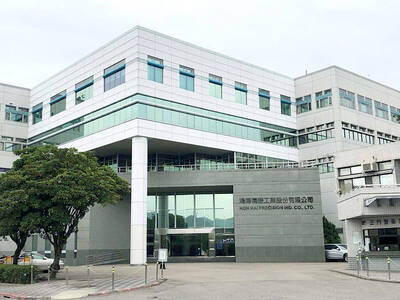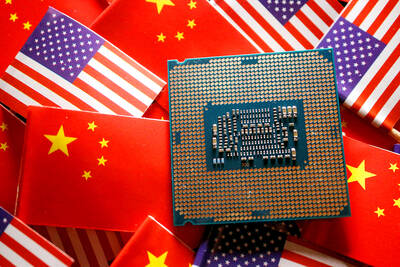It is possible for Apple Inc to move iPhone production to America, but it would almost double the cost of making the device while creating logistical headaches, according to Bank of America (BofA).
“iPhone cost can increase 25 percent purely on higher labor cost in the US,” BofA analysts led by Wamsi Mohan wrote in a note to clients on Wednesday.
While the tech giant can find domestic labor for assembly, a “significant portion” of parts used in manufacturing the iPhone would still be assembled in China and imported to the US, they added. Assuming Apple has to pay reciprocal tariffs on those imports, its total cost would rise 90 percent or more, they estimated.

Photo: Hector Retamal, AFP
The estimate comes as US President Donald Trump zeros in on China for his trade fight. The Trump administration paused its reciprocal tariffs on dozens of countries for 90 days, but increased its duties on China to 125 percent. Meanwhile, China slapped 84 percent retaliatory levies on American goods.
Fear of price increases spurred iPhone panic buying last weekend, while Apple chartered cargo flights to ferry 600 tonnes of iPhones, or as many as 1.5 million, to the US from India, in an effort to beat Trump’s tariffs, sources told Reuters.
For Apple to make relocating its final assembly of iPhones to the US viable, it would need tariff waivers on components and sub-assemblies manufactured outside of the country, Mohan wrote. However, he doesn’t see this happening.
“Unless it becomes clear as to how permanent the new tariffs are, we do not expect Apple to take the step of moving manufacturing into the US,” Mohan said. “We do expect, however, that Apple will continue to diversify its supply chain, and also increase production of iPhones in other countries such as India.”
As Apple diversifies its manufacturing beyond China, it has positioned India for a critical role. Taiwan’s Foxconn Technology Group (富士康) and India’s Tata Electronics Pvt Ltd, its two main suppliers there, have three factories in all, with two more being built, Reuters reported.

Shares in Taiwan closed at a new high yesterday, the first trading day of the new year, as contract chipmaker Taiwan Semiconductor Manufacturing Co (TSMC, 台積電) continued to break records amid an artificial intelligence (AI) boom, dealers said. The TAIEX closed up 386.21 points, or 1.33 percent, at 29,349.81, with turnover totaling NT$648.844 billion (US$20.65 billion). “Judging from a stronger Taiwan dollar against the US dollar, I think foreign institutional investors returned from the holidays and brought funds into the local market,” Concord Securities Co (康和證券) analyst Kerry Huang (黃志祺) said. “Foreign investors just rebuilt their positions with TSMC as their top target,

REVENUE PERFORMANCE: Cloud and network products, and electronic components saw strong increases, while smart consumer electronics and computing products fell Hon Hai Precision Industry Co (鴻海精密) yesterday posted 26.51 percent quarterly growth in revenue for last quarter to NT$2.6 trillion (US$82.44 billion), the strongest on record for the period and above expectations, but the company forecast a slight revenue dip this quarter due to seasonal factors. On an annual basis, revenue last quarter grew 22.07 percent, the company said. Analysts on average estimated about NT$2.4 trillion increase. Hon Hai, which assembles servers for Nvidia Corp and iPhones for Apple Inc, is expanding its capacity in the US, adding artificial intelligence (AI) server production in Wisconsin and Texas, where it operates established campuses. This

US President Donald Trump on Friday blocked US photonics firm HieFo Corp’s US$3 million acquisition of assets in New Jersey-based aerospace and defense specialist Emcore Corp, citing national security and China-related concerns. In an order released by the White House, Trump said HieFo was “controlled by a citizen of the People’s Republic of China” and that its 2024 acquisition of Emcore’s businesses led the US president to believe that it might “take action that threatens to impair the national security of the United States.” The order did not name the person or detail Trump’s concerns. “The Transaction is hereby prohibited,”

Garment maker Makalot Industrial Co (聚陽) yesterday reported lower-than-expected fourth-quarter revenue of NT$7.93 billion (US$251.44 million), down 9.48 percent from NT$8.76 billion a year earlier. On a quarterly basis, revenue fell 10.83 percent from NT$8.89 billion, company data showed. The figure was also lower than market expectations of NT$8.05 billion, according to data compiled by Yuanta Securities Investment and Consulting Co (元大投顧), which had projected NT$8.22 billion. Makalot’s revenue this quarter would likely increase by a mid-teens percentage as the industry is entering its high season, Yuanta said. Overall, Makalot’s revenue last year totaled NT$34.43 billion, down 3.08 percent from its record NT$35.52